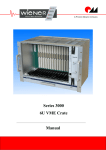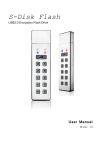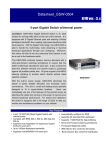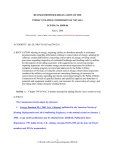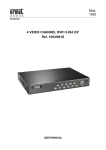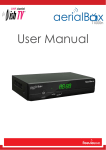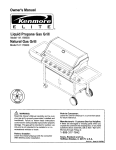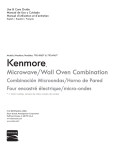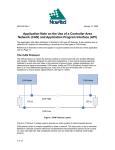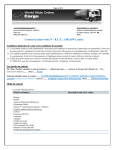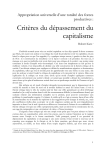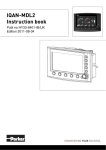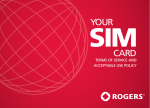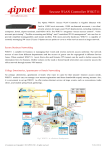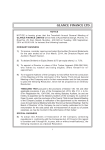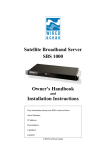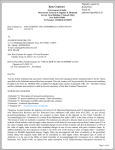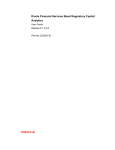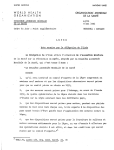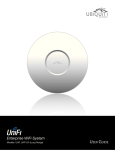Download DTH Recomm. - Cable Quest
Transcript
Telecom Regulatory Authority of India Recommendations on Licensing Issues relating to DTH August 25, 2006 TRAI HOUSE A-2/14, SAFDARJUNG ENCLAVE NEW DELHI-110 029 Table of Contents Sections Page No. Section 1 Background 1-2 Section 2 Personal Video Recorders and Interoperability 3-7 Section 3 Uplinking for Platform Services 8-11 Section 4 Multiple Dwelling Unit (MDU) Technology 12-19 Section 5 Summary of Recommendations 20-21 Annexure I Letter of Government of India dt.3.5.2006 (MDU) 22 Annexure II Letter of Government of India dt.3.5.2006 (PVRs & Uplinking) 23 Annexure III Letter of M/s Tata Sky Ltd. dt. 13.3.2006 24-25 Annexure IV Letter of M/s Tata Sky Ltd. dt. 16.3.2006 26-29 Annexure V Letter of M/s Tata Sky Ltd. dt. 21.3.2006 30-31 Annexure VI Views of stakeholders 32-55 Section - 1: Background 1.1 M/s. Tata Sky Ltd. is one of the two licensees currently providing Direct To Home (DTH) services in the country. Before the rollout of their services, certain clarifications were sought by M/s. Tata Sky Ltd. from the Government regarding the license conditions for DTH services providers. 1.2 The Ministry of I&B, Government of India, in turn sought recommendations of TRAI (hereinafter called the “Authority”) on the licensing issues relating to DTH services on which clarifications were sought by M/s. Tata Sky Ltd. The letters of Ministry of I&B, Government of India and M/s. Tata Sky Ltd. are attached as Annexures I to V of these Recommendations. The issues that require to be addressed are briefly indicated here and are set out more fully in the respective sections in which these issues are discussed in detail:- i) Whether there is any need for amendment of the license conditions to exclude personal video recorders (PVRs) /digital video recorders (DVR)s) from the requirement of interoperability as mandated in clauses 7.1 and 7.2 of the DTH License Conditions. ii) DTH operators provide platform services to their subscribers to enable them to use the service efficiently. Do the provision of these services require any permission under the uplinking guidelines? 1 iii) Whether the use of Multiple Dwelling Unit (MDU) technology is in conformity with the licensing conditions and if so are any safeguards required? 1.3 Consultation Process In line with its consultative approach, the Authority issued a Consultation Paper on June 5, 2006 for giving its recommendations to the Government on the licensing issues relating to DTH services. The consultation paper covered the representations made by M/s. Tata Sky Ltd. on the issues as well as the views on interoperability of M/s. ASC Enterprises Ltd., which is the other DTH licensee in the country. Apart from the specific issues referred by the Government for recommendations, the consultation paper also sought views of the stakeholders on future course of action for dealing with the issues raised by M/s. Tata Sky Ltd. Comments were received on the consultation paper from a number of stakeholders. The Authority held a consultative meeting with all the stakeholders who had submitted written responses to the Consultation Paper. The meeting was held on 12th July 2006 in Delhi. 2 Section - 2: Personal Video Recorders and Interoperability 2.1 A PVR/DVR is a device that is similar to a Video Cassette Recorder (VCR) but records television data in a digital format as opposed to the VCR’s analog format. VCRs utilize analog tapes to record and play programs broadcast over television, but PVRs/ DVRs encode video data in digital format and stores the data in a hard drive. These have all of the functionalities of VCRs (recording, playback, fast forwarding, rewinding, pausing) along with the ability to instantly jump to any part of the program. These features can be used for different functions like pausing live TV, instant replay of interesting scenes and skipping advertising. 2.2 A DTH Set Top Box (STB) with a PVR/ DVR is more expensive as compared to a STB without a PVR/ DVR. Moreover, the technical specifications vary with the models that are introduced and these were not addressed when STB specifications were drawn up by the Bureau of Indian Standards (BIS). It is not possible, at present, to have technical interoperability for all the functionalities of a DTH STB with a PVR/ DVR. 2.3 Articles 7.1 and 7.2 of the DTH License Agreement lay down the following conditions regarding interoperability. “7.1 The Open Architecture (non-proprietary) Set Top Box, which will ensure technical compatibility and effective interoperability among different DTH service providers, shall have such specifications as laid down by the Government from time to time. 3 7.2 The Licensee shall ensure subscribers interests through a Conditional Access System (CAS), which is compatible with an open Architecture (non-proprietary) Set Top Box.” 2.4 The specifications for the STB have been separately laid down by the BIS. These specifications ensure that clauses 7.1 and 7.2 of the License Agreement are complied with. The major objective of these conditions is to ensure competition amongst service providers so that consumers can shift from one service provider to the other. 2.5 The present license conditions mandate technical interoperability for STB for DTH service. The request of M/s Tata Sky is that this condition should not apply for the advanced version of the STB with a PVR/DVR as the value added features cannot be made interoperable for technical reasons. 2.6 The primary issue for consultation that arises from the request of M/s. Tata Sky Ltd. is whether clauses 7.1 and 7.2 of the DTH license conditions should be amended to exclude STB with a PVR/DVR. The related issue is that of the safeguards that should be provided to ensure that consumers can switch from one service provider to the other in case the technical interoperability condition is waived. Safeguards would also be required to ensure that consumers are fully aware of the limited interoperability of STBs with PVRs/DVRs. 4 Comments of the stakeholders 2.7 The majority view of the stakeholders is that it is better to have interoperability conditions on all types of STBs. The views of different respondents are available at Annexure VI. During the course of the consultative meeting on July 12, 2006 some stakeholders suggested that the Authority should define the basic minimum functions which should be interoperable even for STBs with PVRs. Another view that emerged was that new applications are coming up every week and if the STBs are made available on rent, then there will be no bottlenecks in technological progress and at the same time the interests of consumers will be protected. In this context it was also pointed out that for the cable industry it is mandatory to provide a rental option for STB in areas where the CAS is implemented. Analysis of Comments and Recommendations of the Authority 2.8 The comments made by the stakeholders on the issue are primarily focused on protection of interests of the consumers. There are two options at present - either to continue with the licensing conditions, or amending the licensing conditions to remove the requirement of technical interoperability for PVRs/DVRs. However, the main problem is that both the options have their disadvantages. Mandating technical interoperability has the disadvantage that all the functionalities of the STBs with PVRs cannot be made interoperable and only some limited functions will be interoperable. On the other hand, waiver of interoperability condition may lead to a situation where a subscriber gets stuck with a STB as and when he/she changes the service provider. The comments regarding informing the consumer about limited interoperability of the STB 5 underline the need to educate consumers about the limitations/ disadvantages that he may face in case he wishes to change the DTH service provider. 2.9 It has emerged during the consultation process that it is possible for a STB with a PVR to be technically interoperable for reception of DTH service as well as for the recording, fast forward, rewind and pause functionalities. However, the Electronic Programme Guide (EPG) and Video On Demand functionalities and other advanced features are unlikely to be interoperable. 2.10 While it may be in the interest of consumers to have as many interoperable functionalities as possible, the technical and cost considerations rule out mandating interoperability for advanced features at present. In case of a change in service provider, the disadvantage to a consumer may be of losing a part of the STB functionalities. 2.11 At the same time, the consumer should be aware of possible loss of part of functionalities of an advanced STB with a PVR in case of a change in service provider so that he/she can make an informed choice. The issue of interoperability has also to be viewed in the context of similar provisions for Cable TV, since both the platforms compete with each other in providing pay TV services. In the case of Cable TV there is no requirement of technical interoperability. Instead, the Authority has opted for commercial interoperability for Cable TV (commercial interoperability means the requirement to provide a rental option for STB to the consumers so that they can switch from one service provider to another service provider, if they so wish without taking STB with them). 6 2.12 While it may be better to have uniform practice regarding interoperability requirements across all platforms, it may not be advisable to make changes at this stage as both the platforms have developed in accordance with the respective provisions and their commercial models. In view of the fact that technical interoperability in respect of basic functions of STBs has already existed for DTH service, it may be worthwhile to examine this issue after some experience of actual operation of the two DTH service providers is available to understand how technical interoperability is working. Accordingly, the Authority recommends the following: • There should not be any amendment in Articles 7.1 and 7.2 of the DTH License Agreement which mandate technical interoperability among DTH service providers. • The license conditions should be amended to provide for casting an obligation on the service provider to inform and educate the consumers about the limited technical interoperability of the Set Top Boxes with Personal Video Recorders/Digital Video Recorders. • The DTH Service Providers should also be encouraged to provide Basic or Advanced Set Top Boxes to consumers under rental schemes, but there should be no dilution in the interoperability conditions as they exist today. 7 technical Section - 3: Uplinking and Platform Services 3.1 M/s. Tata Sky Ltd. has represented that as a part of its DTH service it proposes to launch a number of platform services which are intrinsic to the DTH service with the aim of enabling the subscribers to utilize the platform efficiently and inform them of platform functionality and services. These include Subscriber help channel to cover use of remote, use of Interactive Voice Response system, how to order Pay Per View programmes, new functionalities etc.; Barker channel (describing platform services to potential subscribers); Navigational service with a pictorial listing of all the broadcasters' channel logos for easy navigation; Helpdesk service to provide easy answers to platform service questions, without the subscriber having to call the call centre. It has been submitted that these platform services are not in the nature of routine commercial broadcaster activity. 3.2 The Government had notified the consolidated uplinking guidelines in supersession of all previous guidelines on the 2nd December 2005. The guidelines came into effect from the date of notification and are applicable to existing channels also. As per these guidelines any company shall uplink only those TV channels which are specifically approved or permitted by the Ministry of I&B for uplinking from India. 8 3.3 M/s. Tata Sky Ltd. have sought confirmation from the Ministry of I&B that the platform services aimed at enabling the subscribers to utilize the platform efficiently and inform them of platform functionality and services are exempted from the uplink licensing requirement. The issue for consultation was whether the Guidelines for Uplinking from India should be amended to specifically exclude platform services aimed at enabling the subscribers to utilize the platform efficiently and inform them of platform functionality. Comments of the stakeholders 3.4 Almost all stakeholders have suggested that the platform services should be exempted from the uplinking license requirement. The views of different respondents are available at Annexure VI. Analysis of Comments and Recommendations of the Authority 3.5 The comments received on the issues of platform services are unanimous in saying that the platform services must be permitted. However, the real issue is that of exemption from uplinking guidelines for these platform services aimed at enabling the subscribers to utilize the platform efficiently and informing them of platform functionality and services. The majority of stakeholders who have responded on the issue have recommended exemption of these services from the approval requirement under the uplinking guidelines. 3.6 The unanimity in views on desirability of having such platform services indicates the usefulness of such platform services which are aimed at enabling 9 the subscribers to utilize the platform efficiently and informing them of platform functionality and services. However, unrestricted exemption from registration under uplinking guidelines for platform services can be misused, for example, for transmitting information which would normally require registration under uplinking guidelines. Therefore, it may not be appropriate to grant exemption to such platform services from uplinking guidelines without laying down the norms to be followed for these platform services. 3.7 Accordingly, the Authority recommends the following: The Guidelines for Uplinking from India should be amended to exclude DTH platform services aimed at enabling the subscribers to utilize the platform efficiently and informing them of platform functionality and services. The license conditions for DTH service providers should be amended to lay down the following norms for platform services which do not require approval/permission under the Guidelines for Uplinking from India :1) The platform services available on the DTH licensee’s system should be only to inform and help the subscriber and should lead to channels which are : a) Approved/registered under the uplinking/downlinking guidelines ; or b) Other exempted platform services, if any. 2) The service provider shall furnish a list of such services being offered to the Licensor annually and also within 15 days of any change in the services. 10 3) The service provider shall comply with the Programme Code and Advertisement Code, as laid down by the Ministry of Information & Broadcasting from time to time, in respect of these services. 11 Section - 4: Multiple Dwelling Unit Technology 4.1 In multi-storied buildings, the DTH services can be provided to the subscribers through a single common dish for the building as a whole rather than using individual dishes for each home. This dish is connected to the individual home through a cable system. For each TV set there is a need for a separate STB1. This is called the Multiple Dwelling Unit (MDU) technology for DTH services. 4.2 There is no specific mention of the MDU technology in the DTH license conditions. The letter of the Government of India No. 8/3/2006 – BP&L dated 3.5.2006 as well as the letter of M/s Tata Sky Ltd. dated 21.3.2006 also do not refer to any specific provision of the license conditions. 4.3 The main issue associated with the use of MDU technology is whether the use of MDU technology is in conformity with the license conditions for DTH services. The associated issue is that if the use of MDU technology is not in conformity with the license conditions then which specific clause of the license conditions is violated. Finally, the issue for consultation was whether the license conditions should be modified either to specifically permit this technology or to prohibit this technology. Comments of the stakeholders 4.4 The comments received on the issue of MDU technology are sharply divided. The Multi System Operators and Cable Operators have opined that is of course possible for one STB to provide signals to many TVs but there would be no choice of programme for multiple TVs and they can only show those programmes selected from the STB. 1 It 12 the MDU technology violates the license conditions. The DTH service providers, Conditional Access vendors, Residents of Group Housing societies have claimed that the MDU technology is in conformity with the license conditions. Amongst those who have argued in favour of MDU technology, there is no unanimity as to whether there is any need to regulate the use of MDU technology or not. Some of the stakeholders have also stated that use of MDU technology is a violation of the Cable Act. The views of different respondents are available at Annexure VI. Analysis of Comments and Recommendations of the Authority 4.5 While no specific clause of the license conditions has been pointed out by most of the opponents of MDU technology, it has been opposed on the grounds of – 1. MDU technology is an intermediary and takes away the direct to Home nature of DTH. 2. It will convert DTH operators into another cable TV service provider. 3. MDU technology is a part of Headend In the Sky (HITS) for which a separate license and services of a cable operator are needed. 4. One stakeholder has referred to clause 6.4 of the DTH license agreement and stated that obtaining permission from building society amounts to assignment of rights of DTH operator to building society. 5. Bigger antenna for MDU technology violates clause 7.4 of the license conditions. 13 Each of these comments are discussed in detail below: MDU technology is an intermediary and takes away the direct nature of DTH 4.6 In the guidelines for the DTH licenses, the following has been stated: “Direct-to-Home (DTH) Broadcasting Service, refers to distribution of multi channel Television programmes in Ku Band by using a Satellite system by providing TV signals direct to subscribers’ premises without passing through an intermediary such as cable operator.” It should be noted that the guidelines lay down that DTH service should be provided without passing through an intermediary like a cable operator. It did not envisage any operational/commercial intermediary between the DTH operator and the consumer. The MDU technology does not create an operational/commercial intermediary between the DTH operator and the consumer. It is also important in this context to recognize that even without the MDU technology there is a requirement of a dish and a cable connecting the dish to the television set of the consumer. The MDU technology has to be regarded as a solution to minimize the number of dishes on a building and also to provide service to those consumers who are not in the line of sight of the satellite. For all the above reasons, it is not correct to say that the MDU technology becomes an intermediary and violates the spirit and the license conditions of the DTH service. 14 The MDU technology will convert DTH operator into another cable TV service provider. 4.7 The MDU technology does not on its own have any capability of providing the normal Cable Television service. It is only a supporting device to carry the signals of the DTH service provider to the consumers. Even without the installation of the MDU technology, there is some equipment and cable between the DTH system and the television set of the consumer. However, in order to protect the interests of the cable operators, it is necessary to ensure that the MDU technology should not be used for any other purpose except for carrying the signals of the DTH service provider. This should be made a condition for permitting the MDU technology. The license conditions should be amended accordingly. MDU technology is a part of HITS 4.8 It has been stated that this technology is a part of Headend in the Sky (HITS) and for which a separate license is required. This is not correct since MDU technology is only meant to facilitate the reception of signals by a customer from the DTH service provider. The HITS technology is completely different in as much as the consumer cannot get the signals directly from the HITS operator because of the need for additional devices at the level of MSO/cable operator, whereas in the case of MDU technology, no further intervention is required before the signals reach the consumer. Thus it cannot be said that for the operation of MDU technology, a separate license is required. 15 Assignment of rights is not permitted. 4.9 This contention is not correct because there is no assignment of rights by the DTH service provider. The use of MDU technology is only for the limited purpose of making its easy for the consumer to access the DTH signal. The DTH operator is directly accessing the subscriber, and there is no intermediate entity to whom the rights are being assigned. Therefore, this objection cannot be sustained. Bigger Antenna for MDU technology violates clause 7.4 of the license conditions 4.10 This has been carefully examined and it is found that all that clause 7.4 says is that the license shall not use any equipment which is identified as unlawful. The use of a bigger dish cannot be said to be unlawful if it is not in violation of BIS standards. 4.11 Another suggestion has been made that even if the MDU technology has to be provided a situation should not be created such that once a DTH operator enters the building with the MDU technology, then other operators whether DTH or cable are prohibited from entering the building of the society. This is an important consideration. The essential objective in permitting alternatives (to the cable industry) like DTH is to ensure that these alternatives provide choice to the consumers. Through such choice there would be competition which should ensure reasonable rates and a good quality of service. Therefore, in order to ensure that no local monopolies are created by the use of MDU technology the license conditions should specifically provide 16 that the licensee should not enter into any exclusive arrangement to the detriment of other distributors of Television channel for installation of MDU technology. This would ensure that the cable operators are not denied a chance to compete. Further, this would also mean that consumers will always be able to have the benefit of competition from both – the cable operator and the DTH service provider. 4.12 On a similar basis there has to be some restraint to ensure that housing societies and building owners do not enter into a contract that would bind their members or tenants or future purchasers. Accordingly, the permission to install MDU technology should only be given with the consent of each consumer who is actually going to get the service. Therefore, the license conditions should also provide that the DTH service providers should also ensure that before installing the MDU technology in any building, the permission from individual subscribers who want this service should be obtained. Any general permission obtained from an office bearer of a Residents Welfare Association or of a group housing society will not be considered sufficient. 4.13 The MDU technology is ideal for multi storied buildings because it reduces the number of dishes and also provides a solution for consumers who are not in the line of sight of the satellite. Therefore, the signals from the MDU technology must not be permitted to be carried to any building outside the premises of a particular multi storied building. 4.14 Apart from the above the MDU technology has various advantages. The consumers in a multi-storied apartment or a society can use the common dish 17 and thereby reduce the space occupied by putting multiple dishes on the buildings. This also helps in reducing the cost to the consumers and making the building / society look neat and clean. For those consumers whose flat does not have a direct line of sight of the satellite, this offers a neat and convenient solution for getting the signals of the DTH service. Thus the provision of MDU technology is definitely in the interest of the consumers as it ensures access to the signals in an easy and cost effective manner. In view of these advantages to the consumers, it is clear that the MDU technology should be permitted and to avoid dispute the license conditions should be specifically amended to promote this solution to be offered. 4.15 It is evident that the use of MDU technology facilitates the DTH service and serves the overall objectives of the DTH guidelines. It has to be viewed as a collective reception system, with the specific consent of the individual consumers. The existing license does not prohibit the use of MDU technology. The Authority is of the view that the interpretation and approach regarding license terms and conditions should be such that it promotes the overall objective of serving the consumer. The MDU technology does not change the nature of the DTH service. In fact, internationally such solutions are seen as an intrinsic part of the DTH business. 4.16 At the same time it is necessary to protect the cable industry and ensure that there is no exclusive arrangement regarding supply of pay TV services within a building if MDU technology is installed. All the distributors of TV channels should have a right to serve their customers in the building and installation of MDU technology should not put any other distributor of TV 18 channels in a disadvantageous position, nor should the MDU technology be used to provide signals of service providers other than the DTH operator. Accordingly, the Authority recommends the following: The DTH license conditions should be amended to specifically permit use of MDU technology subject to the following conditionsa. The DTH service provider should not insist on any exclusive arrangement for installation of MDU technology to the detriment of other distributors of TV channels; b. Signals from the MDU technology shall not be provided to a consumer outside the multi-dwelling unit building, where the MDU technology is installed; c. The MDU technology should not carry the content from any other service provider other than the DTH service provider; and d. The DTH operator shall obtain written consent from those subscribers living in a multiple dwelling unit who are desirous of availing the facility of MDU technology, before installing the same. A general permission obtained from office bearers of the Residents Welfare Association/Group Housing Society will not be considered sufficient. 19 Summary of Recommendations Personal Video Recorders and Interoperability • There should not be any amendment in Articles 7.1 and 7.2 of the DTH License Agreement which mandate technical interoperability among DTH service providers. • The license conditions should be amended to provide for casting an obligation on the service provider to inform and educate the consumers about the limited technical interoperability of the Set Top Boxes with Personal Video Recorders/Digital Video Recorders. • The DTH Service Providers should also be encouraged to provide Basic or Advanced Set Top Boxes to consumers under rental schemes, but there should be no dilution in the technical interoperability conditions as they exist today. Uplinking and Platform Services The Guidelines for uplinking from India should be amended to exclude DTH platform services aimed at enabling the subscribers to utilize the platform efficiently and informing them of platform functionality and services. The license conditions for DTH service providers should be amended to lay down the following norms for platform services which do not require approval/permission under the Guidelines for uplinking from India :1. The platform services available on the DTH licensee’s system should be only to inform and help the subscriber and should lead to channels which are 20 a) Approved/registered under the uplinking/ downlinking guidelines ; or b) 2. other exempted platform services, if any. The service provider shall furnish a list of such services being offered to the Licensor annually and also within 15 days of any change in the services. 3. The service provider shall comply with the Programme Code and Advertisement Code, as laid down by the Ministry of Information & Broadcasting from time to time, in respect of these services. Multiple Dwelling Unit Technology The DTH license conditions should be amended to specifically permit use of MDU technology subject to the following conditions: a. The DTH service provider should not insist on any exclusive arrangement for installation of MDU technology to the detriment of other distributors of TV channels; b. Signals from the MDU technology shall not be provided to a consumer outside the multi-dwelling unit building, where the MDU technology is installed; c. The MDU technology should not carry the content from any other service provider other than the DTH service provider; and d. The DTH operator shall obtain written consent from those subscribers living in a multiple dwelling unit who are desirous of availing the facility of MDU technology, before installing the same. A general permission obtained from office bearers of the Residents Welfare Association/Group Housing Society will not be considered sufficient. 21 Annexure-I No.8/3/2006-BP&L GOVERNMENT OF INDIA MINISTRY OF INFORMATION & BROADCASTING ‘A’ Wing, Shastri Bhawan, New Delhi-110 001. Dated: 03.05.2006 To: The Telecom Regulatory Authority of India, A.2/14 Safdarjung Enclave, New Delhi – 110 029. Subject: Representation received from M/s Tata Sky Limited regarding MDU or Multiple Dwelling Unit Solution through DTH. Sir, I am directed to state that M/s Tata Sky Limited has signed a License Agreement for DTH Service operation on 24.3.2006 with the Government. The Ministry has received a representation dated 21.3.2006 from M/s Tata Sky Limited on the above subject, a copy of which is enclosed. 2. TRAI is requested to examine the issues contained in the representation and forward its recommendations to this Ministry in terms of Section 11(1) of the TRAI Act, 1997. Yours faithfully, Sd/(G. Chatterjee) Under Secretary to the Govt. of India Tel: 23389202 Encl: As above 22 Annexure-II No.8/5/2006-BP&L GOVERNMENT OF INDIA MINISTRY OF INFORMATION & BROADCASTING ‘A’ Wing, Shastri Bhawan, New Delhi-110 001 Dated: 03.05.2006 To The Telecom Regulatory Authority of India, A-2/14 Safdarjung Enclave, New Delhi – 110 029. Subject: Representation received from M/s Tata Sky Limited for amendment in license conditions of DTH on requirement for new generation PVRs and non-applicability of uplink license for platform services. ***** Sir, I am directed to state that M/s Tata Sky Limited signed the LicenseAgreement for DTH Service operation on 24.3.2006 with the Government. The Ministry has received two representations dated 13.3.2006 and 16.3.2006 from M/s Tata Sky Ltd on the above subject, copies of which are enclosed. 2. TRAI is requested to examine the issues contained in the representations and forward its recommendations to this Ministry in terms of Section 11(1) of the TRAI Act, 1997. Encl: As above Yours faithfully, Sd/(G.Chatterjee) Under Secretary to the Govt. of India Tel: 23389202 23 Annexure – III TATA SKY March 13, 2006 Shri S.K. Arora, Secretary, Ministry of Information & Broadcasting, Shastri Bhawan, ‘A’ Wing, New Delhi-110 001. Dear Shri Arora Re: PVRs I am pleased to attach a representation to the TRAI seeking an amendment in the license conditions for DTH platforms so that technical interoperability requirements can be waived for new generation PVRs that will be launched in India. I would be grateful for your kind consideration on this matter. With kind regards, Sd/(Vikram Kaushik) CEO Tata Sky Limited 24 TATA SKY Subject: Launch of PVR’s in India 1. PURPOSE : The objective of this note is to present the case for the launch of high-end PVR’s in India on our DTH platform. We have set out the issues involved in a brief presentation that is attached with this note. 2. PRODUCT: The PVR is a premium product (around four times more expensive than standard set top boxes) meant for discerning consumers who are willing to pay higher prices for a variety of new services and better functionalities while viewing television. The consumer who will buy this product will do so out of choice, understanding that interoperability is not available with PVR’s. PVR’s come with a hard drive of 40 GB to 160 GB, 1 to 4 tuners and higher specification chipsets. They allow consumers to pause live television, record one programme while watching another, allow skipping and review of programmes among other features. 3. TECHNOLOGY: PVR’s are new, high-end technology devices that are not meant for the mass market. The technical specifications vary with the models that are introduced and these were not envisaged when STB specs were drawn up by BIS. Besides, the Common Interface Specification (EN 50221) was created in 1997 and only supports basic TV viewing and not products with a hard drive and/or advanced services. PROPOSAL: Since the hard drive is the key resource in a PVR and standard, linear TV viewing is only a small part of the usage for such a set top box the Common Interface has little relevance in this device. We would urge the Authority to kindly amend the license conditions for DTH platforms and waive interoperability requirements for PVR’s. This will allow the free flow of global technology to India. The basic set top boxes would be available to the mass market consumer and provide the interoperability required under the license conditions. 25 Annexure – IV TATA SKY March 16, 2006 Shri S.K. Arora Secretary Ministry of Information & Broadcasting Shastri Bhavan, ‘A’ Wing, New Delhi-110 001. Subject: Non applicability of uplink license for Platform services Dear Shri Arora, Tata Sky has represented on several occasions that as a part of its DTH service it proposes to launch a number of platform services which is intrinsic to the DTH service and whose sole aim is to enable subscribers to utilize the platform efficiently and inform them of platform functionality and services. These platform services are: 1. Subscriber help channel 2. Barker channel (describing platform services) 3. Home 4. Helpdesk 5. Guide 6. News Desk During our conversation on February 20 we had discussed this and you had indicated that uplink licenses might not be required for such platform services. We are enclosing an annexure that provides a brief description of the functionality and purpose of each of these platform services. From a review of these services it will be clear that these are meant to facilitate the viewing experience of the Tata Sky platform by providing easily accessible information. 26 Therefore, these services are not in the nature of routine commercial broadcaster activity and we believe, should not be treated as such. In view of the above, we would like to request the Ministry of I&B to kindly confirm that these platform services are exempted from the uplink licensing requirements. With kind regards, Yours sincerely, Sd/(Vikram Kaushik) CEO Tata Sky Limited. 27 TATA SKY DESCRIPTION OF THE PLATFORM SERVICES 1. Subscriber help channel This is an audio video channel that will have 2-3 short films looped continuously. The purpose is to inform the subscriber of platform services and their functionality. The content will be updated no more than once a month and will cover: • How to use the remote • How to use IVR / send SMSs / order PPV • New platform functionality, if any • Short promos of existing duly registered and licensed 3rd party broadcaster channels, interactive services and PPV events. The subscriber help channel will be listed as part of the EPG but will not have any programme schedule listing. The channel will not support any form of interactivity. 2. Barker channel (describing platform services) This is an audio video channel that will have 2-3 short films looped continuously. It is an information service for potential subscribers and can be viewed in retail outlets and other points of sale. It will be available in two languages Hindi and English. The content will be updated no more than once a month. The content will include material that will be used to highlight the salient features of the service. It will be listed as part of the EPG but will not have any programme schedule listing. The channel will not support any form of interactivity. 3. Home Service This is an interactive service that is a navigational service. It is a pictorial listing of all the 3rd party broadcasters' channel logos that allows easy navigation to 3rd party services. 28 It will be accessed in 3 ways: • Default service at power-on of the STB • Direct access through a dedicated remote button • Listed in the EPG Interactive Menu Key Functionality of the service are: • Navigator homepage will provide easy access to the channel genres • The Navigator will provide a quarter-screen video window in which the video feed of any selected channel can be viewed. The subscriber can view the title of the current program being broadcast on each channel and the lapsed time indicator. If the subscriber has viewing rights to the channel, the quarter screen video can be expanded to full screen. • If a viewer tries to access a channel that has been blocked by the user through the EPG or a programme that is blocked by parental control, the navigator application will be able to block the viewer from viewing the channel/ programme. 4. Help Desk: A text based interactive service that is a help application to provide easy answers to platform service questions, without the subscriber having to call the call centre. • It will be accessed in 3 ways: o Direct access through a dedicated remote button o Navigator home page o Interactive Services menu Key Functionality is: o Designed to inform and aid the subscriber, the subscriber help screens willcarry answers to frequently asked subscriber questions. It will cover topics like product packages, billing, how to order PPV, basic hardware diagnostics, promotions etc. o Wrapped around the subscriber help channel which is broadcast in ¼ screen. 29 Annexure - V TATA SKY March 21, 2006 Shri S.K. Arora Secretary, Ministry of Information & Broadcasting Shastri Bhavan, ‘A’ Wing, New Delhi-110 001. Dear Shri Arora, Re: MDU or Multiple Dwelling Unit Solution through DTH In the recent weeks several reports have appeared in the press regarding the MDU solution offered by DTH platforms and what these entail. From the contents of an article in The Hindustan Times the key issue seems to be that “by providing wiring from the dish to multiple consumers in a common residential area indicates that Tata Sky is trying to step into the shoes of the cable operator”. In order that there should be clear and accurate information with the Ministry we are pleased to clarify this issue. Our comments are as follows: 1. 2. Providing consumers with the option of receiving their television signals via a DTH dish is in line with the DTH guidelines set down by the Government. It is also in consonance with the license conditions for DTH operators. A DTH television service provides consumers with the choice to upgrade to a digital service. Every single subscriber has to purchase hardware and pay a monthly subscription for the service. What is an MDU solution? All over the world every major DTH operation provides an MDU or “multiple dwelling unit” solution to multi-storied buildings. 30 This is done by installing a single, slightly larger dish in the “line of sight” of the satellite. This dish services various individual settop boxes that subscribers in the building might own. How does it work? This solution is provided for two reasons: 1)apartments that face other buildings might not be in the“line of sight” to the satellite and hence the dish antennaneeds to be located on top of the building so that it canreceive signals from the satellite without any obstructionfrom neighbouring structures. 2) The solution minimizes the number of dish antennae emanating from various apartments. This also minimizes maintenance costs and reduces the “visual pollution” so common in our cities. Many building societies prefer this mode of delivery to individual homes. 3. The MDU solution neither entails the creation of “an headend” for the building as a whole nor does it in any way take away the freedom of individual subscribers to buy or not buy a digital set-top-box to subscribe to the DTH service. Needless to add, the MDU solution is only provided if the building society asks for it and gives written permission. Should you require any further information we would be happy to provide it. With kind regards, Yours sincerely, Sd/(Vikram Kaushik) CEO Tata Sky Limited 31 Annexure VI: Views of the Stakeholders Personal Video Recorders and Interoperability 1. The question of inter-operability should be adhered to even in the case of DTH subscribers with DVRs. It has been proved that when TataSky NDS CA Module is fitted into a DishTV STB, certain functions like EPG will not display correctly/fully. Similarly, when DishTV Conax CA Modules are fitted into Tata Sky set top boxes, the EPG functions will not display fully. Further, in no part of the world, NDS CA Modules are sold in loose. TRAI should ensure that no existing DTH subscriber will have to unnecessarily change their old STBs or shift to another service provider for want of new channel offerings or facilities. (Shri Ganesh Kumar) 2. No DTH service provider must give their own DTH device. (Shri Venkat Prasad) 3. The open architecture STB must be insisted upon to ensure interoperability effectively. PVR (DVR) may be excluded from interoperability. However, STB with DVR should have interoperability to have basic functions like recording facility etc. so that the consumer shifting to another service provider loses only value added features. (Shri Mahesh Prasad) 4. In India, specifications for DTH STBs have been laid down in IS- 15377. Most of the new generation STBs are designed to deliver A-V (Audio- 32 Video) outputs to a TV set. The same output can be routed through a recorder (Personal or otherwise). If such a recorder is a plug and play ‘Add-ON’ to the STB, there won’t be any difficulty. If the recorder circuitry is encased in the same housing as the STB, then the cost of the STB will go up and the gadget will become absolutely proprietary. Use of different CAS, encryption, middleware and EPG make the STB proprietary and hence such STBs cannot remain inter-operable. Hence clause 7.1 needs to be amended to delete ‘open architecture (nonproprietary)’ from the narration in the guide lines as well as the standards. As far as recorders are concerned, IPRs for recordings and their replays shall have to be ensured through Service Level Agreements, restricting number of replays of recordings against each demand. The service provider should be mandated to provide the DTH electronics, as part of service agreement, against a noninterest bearing, refundable, security deposit of the value not exceeding the cost of such electronics. The rentals for the electronics should be allowed to be charged. As and when the subscriber wishes to change the service provider, the receiving electronics can be returned, in serviceable, condition and refund of security deposit obtained. The STB should be screen printed with cautions to the effect that this equipment is compatible for receiving DTH services only from the service provider who is providing the electronics and that it may not work for services provided by any other service provider. This message must appear on the opening page of the screen on TV set through embedded recording in the chip. Each time the TV set is switched on this statutory warning must be flashed. Such warnings should also be got signed by the service provider in the documents for customer acquisition prior to commissioning the service. All business promotional and advertisement 33 literature should also carry such warning. (All India Aavishkar Dish Antenna Sangh) 5. The clauses 7.1 & 7.2 of DTH license conditions need not be amended to exclude digital video recorders. All Set Top Boxes whether simple STB or Personal Video Recorder/ Digital Video Recorder enabled Set Top Boxes should be interoperable as mentioned in Clause 7.1 and 7.2 of DTH licensing conditions, as long as it is clearly communicated and understood by the consumer that certain value added features and functionality of PVR enabled Set Top Boxes would not be available in case he switches from one service provider to another. (M/s. Reliance Infocomm Ltd.) 6. Advanced version of set-top-boxes having built in PVRs and DVRs should be excluded from the purview of clauses 7.1 and 7.2 of the DTH License conditions. This equipment is highly advanced and does not have a large market even in the developed world. Their demand will be very limited and will not affect the masses. Hence for the initial period, may be of one year, they can be excluded from Clauses 7.1 and 7.2. Later on when their prices come down and they become a common feature, they can be brought under these clauses. Buy back schemes can safeguard consumer interest. Such equipment must be available on rent/lease/sale scheme from the service providers. Consumers can be informed of limited inter-operability through advertisements and as a warning on the equipment brochure. They can also be offered on a limited trial basis. A sticker warning at the back of the equipment can also be helpful. (Cable Operators Federation of India) 34 7. Any burden on the subscribers in terms of the new technology should be interoperable even if the set technology is distributed free of cost. The consumers should have the freedom to handover the boxes back to the DTH service provider without any difficulty. There should be an adequate information and publicity with sufficient trial period for such boxes. (Cable Operators & Distribution Association) 8. As far as amendment of the license conditions are concerned asking some DTH boxes (for basic services) to be interoperable and value added boxes not to be interoperable will defeat the very purpose of interoperability. Digital video recorders (DVRs) are quite expensive and if the feature of interoperability is not there, it would give an unfair advantage to a DTH service provider as the subscriber will not be able to shift and would be bound to stay with the same service provider. This is per se “anti-competitive” and should not be permitted. The license condition should not be amended to exempt digital video recorders from interoperability requirements. However, if the Authority decides to recommend the same, then the DTH service provider should also offer buyback for such boxes i.e. un-interoperable boxes (DVR) be offered for sale/buyback as well as on lease rental schemes. It should be advertised extensively for all concerned and they should offer limited trial periods for such boxes. Commercial interoperability (i.e. lease option) must be mandated and subscribers should not be forced to purchase the DVRs. The lease schemes / terms should be filed with TRAI & 30 days cooling off mandated for approval of the Authority for such schemes. (MSO Alliance) 35 9. Interoperability is not feasible on high end devices for the reasons, among others, such as (i) high-end PVR’s (Personal Video Recorder) or Digital Video Recorders in India are premium products (around four times more expensive than standard set top boxes) meant for discerning consumers who are willing to pay higher prices for a variety of value added services and better functionalities while viewing the Television. (ii) PVR’s come with a hard drive of 40GB to 160 GB, 1 to 4 tuners and higher specification chipsets. They allow consumers to pause live television, record one programme while watching another, allow skipping and review of programmes, amongst other features. (iii) PVR’s are new, high-end technology devices that are not meant for the mass market. The technical specifications vary with the models that are introduced and these were not envisaged when BIS drew up STB specifications. (iv) Besides, the Common Interface Specification (EN 50221) was created in 1997 and only supports basic TV viewing and NOT products with a hard drive and/or advanced services. (v) Since the hard drive is the key resource in a PVR and standard, linear TV viewing is only a small part of the usage for such a set top box the Common Interface has little relevance in this device, waiving interoperability requirements for PVR’s will allow the free flow of global technology to India. The clauses 7.1 and 7.2 of the DTH license conditions should be amended to exclude digital video recorders. To ensure that consumers could switch from one service provider to the other, commercial interoperability is the best solution. The consumers can be made aware of the limited interoperability of digital video recorders by way of advertising on packaging of the STBs, DVRs and print media generally. (M/s. TATA Sky Ltd.) 36 10. The clauses should as a minimum be amended to exclude digital video recorders. Preferably, future, optional “high end” set top boxes offering access to advanced services such as high definition TV (HDTV) should also be excluded. Optimally, the clauses should be amended to remove the requirement for technical interoperability altogether, even from future generation basic set top boxes. No additional safeguards are required to ensure that consumers can switch from one service provider to the other. Whatever safeguards are implemented should be common across all pay TV delivery platforms (DTH, cable, IPTV etc) and not be more onerous on one than the others. The question also appears to exclude the possibility of switching to a free-to-air service, or to or from one of the other pay TV DTH platforms to be launched. The best safeguard is to give the consumer clear, accurate information on interoperability limitations at the point of sale, by whatever means are most appropriate. For example, a web based purchase may include a click through notice “I understand that this product is only fully functional as advertised for use with the … DTH service; its functionality will be limited to … if it is used with any other DTH service”. A retail purchase may rely on clear marking on both the DVR carton / packaging and the user manual and on advice of retail staff. (M/s. NDS India) 11. Clauses 7.1 and 7.2 of the DTH license conditions should not be amended. DTH Guidelines were finalized by a GOM which decided that the STBs for DTH reception should be of open architecture considering the interests of a large number (majority) of viewers, i.e it should be nonproprietary so that a consumer need not have to invest each time he/she wishes to change the DTH service provider. A consumer could view any of the DTH service with a single receiver by subscribing to that service and obtaining 37 necessary CA key from the service provider on a smart card/PCMCIA module. Manufacturers of STBs can inexpensively add PVR (Personal Video Recorder) functionality to their advanced set-top box products that address the rapidly growing convergence in the marketplace. These advanced convergence devices offer consumers full control over their viewing experience by providing pause, instant record and other time-shifting features during live broadcasts, as well as offering the ability to record one or more programs at specified times in the future. Hence, just for adding a PVR, the STBs need not be made proprietary. As we have in the market, expensive TVs with additional facilities like P-I-P (Picture-in-picture) etc., which are purchased by a minority, well to do, consumers, there is nothing wrong in producing advanced STBs, which incorporate features like PVR/VTR etc. But these can be of open architecture, since adding a function such as PVR will not make much difference to interoperability except that it will become expensive. Appropriate promos could be carried by STB manufacturers about the availability of advanced features like PVR etc. to motivate the viewers to buy such models which, are still inter-operable or alternately they may provide “exchange” offers to exchange the existing boxes with the advanced boxes at a nominal increase in cost. (Shri Chellam Bose) 12. In ASC’s views there is no need to amend the clauses 7.1 and 7.2 of the licensing conditions. ASC fear that by amending the clauses, the consumer’s interests will be compromised. These clauses protect the consumer interests by ensuring that they switch over their service providers for the basic functionality of watching the broadcasted channels as per their option & choice. In ASC’s view the declaration by the service provider with respect to the capability of the boxes with CI functionality should be sufficient and would adequately protect 38 the consumer interest. As the DVR boxes will provide the interoperability for the basic functions the service providers need to make the consumer aware by declaring the interoperability functionality is limited to the basic services. Since there are going to be multiple service providers, conditional access providers and manufacturer of the DVR the normal process used in the case of DVR is that content over the air is descrambled of the conditional access and then re encrypted by using the standard triple DES before being stored on the HDD of the DVR. The Common Interface is still the only open and standard DVB mechanism for conditional access that provides interoperability. This applies to both DVRs and diskless STBs.Thus, as the Common Interface is mandatory for DVB receiver devices, whether with or without disk, sold to consumers in India, there are two relevant types of DVRs: Type A: DVR with CI only and no parallel proprietary embedded CAS and Type B: DVR with CI and parallel proprietary embedded CAS. Operators wanting to deploy content for possible storage on DVR disk will have the choice of deploying the content to both type A and B, DVRs or just type B DVRs. If operators have concerns regarding the CI, they should target type B DVRs only and use the proprietary embedded CAS, and not the parallel CI. Consumers wanting the content offered by operators releasing the DVR storage content via the proprietary embedded CAS only need to purchase type B DVR. The CI in the type B DVR then preserve the opportunity for the consumer to also access content from other operators without having to obtain another STB or DVR. Conclusion is that operators wanting/needing to control the content end-to-end can promote type B DVRs without compromise on security compared with a non-CI DVR, whereas a type B DVR gives the consumer the flexibility to use the DVR to access content also from other operators which non-CI DVRs not provide. (M/s. ASC Enterprises Ltd.) 39 Uplinking and Platform Services 13. It is all right if platform services are exempted from uplinking licensing requirement. (Shri Mahesh Prasad) 14. The license should mention what all is allowed to be uplinked, including platform proprietaries. All DTH operators will have a PLAYOUT component ( proprietary content of the broadcaster) of the content and a TURNAROUND component (re-transmission of TV programmes down linked from satellites or terrestrial telecasts). The platform services, in all likelihood, would pertain to playout component. Such playout services are best appraised through the EPG. The guidelines should add EPG in the component of the content clause 7.2 of the guidelines. Such a guide, created intelligently, will appraise the subscriber of all the functionalities in general and personal recorders in particular. (All India Aavishkar Dish Antenna Sangh) 15. All over the world, DTH operators provide several services which are integral part of DTH platform service offerings. These services are basically informative in nature and mostly contain graphical information. Services like Electronic Programming Guide (EPG) giving details of programs available on various channels along with their schedules, Subscriber Help Channel giving details of functionality of Set Top Box and remote, how to use Interactive Voice Response(IVR) and SMS for ordering Pay Per View or other Value Added Services, short promotional video of upcoming PPV events etc. These services are not in the nature of routine commercial broadcaster activity as also suggested by Tata Sky. Therefore our recommendation is that these services 40 should be exempted from up linking licensing requirement under Ministry of Information and Broadcasting. (M/s. Reliance Infocomm Ltd.) 16. It has not been specified as to what kind of platform services are being made available. Most of these services like EPG are uplinked along with the other channels and the STBs have a special software to make them available to the consumers. Hence there may not be a requirement of changing the guidelines. However, the Ministry can examine the issue from case to case once a request is received. (Cable Operators Federation of India) 17. No need to amend guidelines they can take permission. (Cable Operators & Distribution Association) 18. There is no need to amend guidelines. They can take permission. Platform services being informative in nature are for the benefits of subscribers and should be allowed. (MSO Alliance) 19. The Guidelines for Uplinking from India should be amended. The platform services are part and parcel of the DTH service. Platform services are so intrinsic to the DTH service and the aim being to inform the subscriber and enable him/her to utilize the platform efficiently such as subscriber help channel, Barker Channel (describing platform services), Home, Helpdesk, EPG and News room. There is again no statutory restrictions in most geographies related to platform services and such services can be considered more as a “user manual” for the consumers or as an aid for the subscriber to navigate through the service. By providing these services it stops the subscriber 41 spending money to call the help line for small issues and queries. (M/s. TATA Sky Ltd.) 20. The Guidelines for Uplinking from India should not be amended. Platform Services, which provide EPG etc. will operate on commercial terms by projecting some channels (which pay more or platform’s own/affiliated channels) on the opening/first page or in prominent locations compared to other channels. Hence these services should be guided by the same uplinking guidelines applicable to other TV channels. If at all they need to be exempted from this, then there should be clear norms/codes drawn to regulate such services. (Shri Chellam Bose) 21. Distribution platforms Cable, DTH and upcoming one like IPTV , Mobile TV need to have direct interaction with their customers in order to provide information to the consumers on the various features of the services. It is dependent on the service provider that how many such informative channels the service provider wish to run on the platform. The information channels or the Barker channel as it is called is an essential feature of the any addressable platform. Typically the Set Top Box would get tuned to the Information channel when switched on so that the customers can view relevant information which is service specific. The provision of a barker channel is essential for operation of a DTH network as it provides customers, some of whom may be first time users in a country like India to learn about: the features of the Platform, how to tune the STB to the satellite, how to use Services such as EPG, Games, how to use security features such as PIN code and Parental lock, how to make payments, contact information of the Call centers, help desk etc. and additional features depending on the DTH Platform. Form this point of 42 view the provision of a barker channel or information channel on a DTH platform is entirely in order and. Since through this only the information being provided to the subscriber and the same is within the closed user group of subscriber of the Service Provider, it should be exempt from the requirement to have a registration under the uplinking and downlinking Guidelines. (M/s. ASC Enterprises Ltd.) Multiple Dwelling Unit Technology 22. Multiple Dwelling Unit Technology is the common method of distribution in buildings where all the flats do not have facility for installation of TVROs looking at the DTH satellite. However, the single dish to be installed has necessarily to be much bigger in size then 0.6 meter dishes which generally go with DTH. It will give rise to complaint from cable operators if the cabling done by them in a building is used for carrying the DTH signal. Therefore, while permitting MDU technology in high rises it should be prescribed that separate cabling of various apartments has to be done which does not utilize the cable system set up by the cable operator. (Shri Mahesh Prasad) 23. MDU (In the past known as MATV/SMATV) distribution, which will entail a distribution network to be erected by the Broadcaster, is not deemed to be in conformity with licensing conditions. The spirit of DTH licensing clearly states that the TV transmissions from the satellite should be received directly by the viewer without an intermediary such as a cable operator. Since all content in DTH retransmission is not owned by the DTH operator, is DTH operator not an Intermediary? and would Distribution of DTH channels through an electronic gateway in MDU not make him an intermediary ? If 43 different DTH service providers, (since there is no restriction on number of licenses to be granted), use different satellites, and do not share programs, as many large dishes as the number of satellites used by the DTH operators will be required atop a multi-storey complex. And if each service provider has over 100 channels, one would wonder how would 400 channels from four or five service providers be combined and distributed, through complex electronics likely to be called a distribution gateway, particularly when each service provider uses a different CAS, middleware, EPG and SMS making the set top box proprietary. Would MDU management not get tied to monopoly of first mover? The concept, therefore would be contrary to the intended spirit of DTH. In spirit the definition of DTH does not visualize signal delivery through another distribution network, SMATV/MDU or for that matter Cable Operator’s distribution network. If MDU technology is to be encouraged in the interest of convenience or aesthetics or otherwise, the definition should delete the connotation of intermediary in general and cable operator in particular. Then even LCOs may invest in a distribution gateway and rid themselves of MSO and Right Of Way (ROW) hassles. Address ability will bring in transparency, customer will have a choice to watch what he/she wants in digital quality and without having to invest in a box, if provision of the STB by the service provider is mandated. The LCO will then become a franchisee of the service provider. If the MDU technology is to be permitted then the preamble needs to be changed (since it targets cable operators) or else it should be prohibited. If permitted, the distribution should not be restricted to a building only. It should be extended to a radius of operation technically feasible in cabled environment, HFC/Coax/CAT5 etc. (All India Aavishkar Dish Antenna Sangh) 44 24. The very basic principle and terminology “DTH” is “Direct–To– Home” services to the customer and in the normal parlance and layman’s language can be understood as service provided by the service provider directly at home of the subscriber and not on the rooftop of the Dwelling of housing society, apartments etc. Further, the “Guidelines for obtaining License for providing DTH broadcasting service in India” has been very correctly stated in para 3 that DTH “Direct–to–Home (DTH) Broadcasting Service, refers to distribution of multi channel TV programmes in Ku Band by using a satellite system by providing TV signals direct to subscribers’ premises without passing through an intermediary such as cable operator. An attempt is being made by DTH Service provider(s) to intrude the area of operation, which currently a cable operator is discharging. It is submitted that the concept of Multiple Dwelling Unit Technology will convert the DTH services provider into another cable TV service provider / industry. The DTH concept clearly distinguishes the DTH system from the cable industry by using the words “directly to subscribers premises” and not on the rooftop of the buildings. A DTH Service Provider claimed that MDU solution would reduce “visual pollution” in terms of number of dishes as only one dish needs to be installed instead of number of dishes in the individual dwelling of subscriber, but this would lead to increase wired cable in buildings, whether such wired building would not lead to a visual pollution. It is claimed that many societies prefer providing DTH services by installing “slightly” larger dish on the rooftop of the buildings and that it is on voluntary basis. This is purely an assumption or forthwith conceding with the competition from cable service provider as the new DTH Service provider is yet to begin its operation and therefore should not form an opinion / notion without testing ground reality. In conclusion, it is submitted that any change in the basic structure in terms of the sprit of DTH 45 licensing guideline and change in the original intent of the Government should not be encouraged. Spirit and intent of para 3 of the DTH License Guidelines, would be violated. The existing licensing conditions read with the Government of India Guidelines on providing DTH License are sufficiently clear and is rightly understood by DTH operators / service providers and hence sought to clarify / explain their position by letter dated 21st March 2006 to the Ministry of I & B. (M/s. Hathway Cable & Datacom Private Limited) 25. Provision of MDU solution should be left to market driven forbearance. It should be left to the arrangement / choice between building societies (customers) and service provider. (M/s. Reliance Infocomm Ltd.) 26. MDU technology is not at all in conformity with the licensing conditions. Direct to Home service is direct to the consumer, where as cable service is through an intermediary like cable operator. MDU basically comprises of a Headend and a network of co-axial cables very similar to a cable network. Hence this will make DTH interfere into the territory of Cable TV services giving advantage of both the technologies to the DTH operator which is not fair. Principle of level playing field will be violated here jeopardising the employment of lakhs of people in the cable business. As it is, government wants to restrict cross media holding. It will violate this regulation too. If there are four or more licensee of DTH and if all of them want to provide MDU, the distributors of DTH companies would be fighting over the Housing Colonies like the Cable Operator did years ago. DTH is Home viewing in terms of copyright where as distribution to public through a cable network is public viewing in the legal parlance. How can one license give advantage of both? It 46 may be recollected that Cable TV came in to existence when the commercial right owners of video films objected to Cable Operators showing home viewing Cassettes through cable networks in buildings and societies in Mumbai. The term 'Cable TV Right' was born out of this dispute when the High Court ruled that video distribution through cable network will be deemed as public viewing. Generally, MDU system is operating in countries where cable TV does not exist or has not proliferated to that extent. It is left on the wish of the flat owners in the building to have an MDU system combining the signals of one or two DTH systems, terrestrial TV and even cable TV. The system is not provided by the DTH operators. It is employed when there is no convenient place to install dish antennas. It cannot be permitted as a regular service by the DTH operator. It is the responsibility of the government to ensure there are no monopolies and vertical integration. Regulations have to provide sufficient protection to a person’s business and opportunity for future growth. It cannot afford to send millions of small entrepreneurs on the road to give advantage to the corporates. (Cable Operators Federation of India) 27. The use of MDU technology by DTH licensee is not in conformity of license conditions because the licensing conditions clearly state that Direct to home (DTH) broadcasting service; refers to distribution of multi channel tv programmes in ku band by using a satellite system by providing TV signals direct to subscriber’s premises without passing through an intermediatory such as cable operator. An MDU (Multi Dwelling Unit) system is a technology, which enables the DTH provider to control multiple subscribers like a cable operator through a closed transmission path (network). By using this technology, the DTH service provider is misusing the licensing conditions by becoming a cable operator himself, by laying his own cable network by wiring 47 the building, which was essentially used for the cable TV, thus depriving the cable operators right of way. By definition, if the Cable Operator is an intermediatory, then isn’t the MDU system also an intermediatory? As these companies are huge business houses, with deep pockets, it will be easy to influence the management of the Co-operative buildings (Secretaries/ Chairman) to eliminate cable operators who are already servicing them for the last 10-15 years and creating another monopolistic situation for the remaining members of the society. the Government never intended to allow DTH license providers to offer MDU services. This technology is also a part of HITS under which the government has provided a separate license and a clear-cut direction whereby they have to use the services of a cable operator. The introduction of MDU system by the DTH providers will dilute the whole purpose of choice from the consumers, as this system will encourage a different type of monopoly. (Cable Operators & Distribution Association) 28. The use of MDU technology by DTH licensee is not in conformity of license conditions. The license conditions clearly state that the DTH will not use an intermediate to connect subscribers such as cable operator, it further restricts cross holdings in content/cable companies and hence it allows various technologies and system with different managements to promote healthy competition between various stake holders. In so called MDU system, a network of Cables through an intermediatory (to provide service and maintenance) is required which essentially as per definition brings it under Cable Act. DTH service provider can not become cable operator. Under the garb of MDU, DTH service provider are violating the basic principle of their license condition of restricting them as cable operators, furthermore to install MDU they are using the infrastructure laid for wiring the building i.e. the 48 underground network of CATV/MATV, which was made essentially for Cable TV. This will further deprive cable operator of his Right of Way. Since they have the means & dominance, they will oust cable operator by taking over this Right of Way by influencing management of Co-Op Societies/Buildings. This will also create a vertical monopoly as only one DTH service provider will have this Right of Way and the other DTH service provider will not get this if they do not have the first movers advantage and if the building management decides to provide this facility to only one DTH service provider they will force subscribers to take connection from MDU service provider of their choice, hence, eliminating competition for ever. Scrutiny of the license conditions relating to DTH show that none of the articles specifically provide for use of MDU. However, attention of the Regulator is drawn to the definition of DTH given in Para 3 of the DTH guidelines. Secondly, reference of the Regulator is drawn to the specifications for DTH digital Set Top Box issued by BIS in 2003. On scrutiny of these two, it becomes clear that the Government never intended to allow DTH license providers to offer MDU services. For the detailed reasons as mentioned above, it is suggested that MDU by DTH provider be specifically banned as it will vitally affect the interests of the cable industry. (MSO Alliance) 29. The use of MDU technology by DTH licensee is in conformity with the licensing conditions. No license conditions are being violated. MDU technology is a necessary corollary to DTH service for the reasons, among others, from the technical and commercial structure itself, there is no doubt the intention of the legislation is being complied with as the MDU model visualizes the business relationship only between the DTH operator and the subscriber. It can safely be inferred that DTH MDU model is within the 49 bounds of the above guidelines. Currently Cable TV has a monopoly on provision of services to apartment buildings. Installation of MDU does not restrict the choice of the consumer, who can still opt for Cable / alternate mode. On the other hand, not permitting the MDUs could be construed as a restraint of trade on the DTH service. Exercise of choice by the consumer will ensure, no monopolies take shape in the distribution system. It is also significant that in a MDU system, the main gateway for signal is the STB and the way the signal is delivered from the satellite and the way the wiring is provided is irrelevant. In some major geographies and countries like Spain, it is compulsory for the apartment buildings to have MDU units in respect of DTH services. In other countries (Australia, UK) DTH MDU solutions are very common and are an important part of the DTH business. It is accepted internationally that MDU solution is an intrinsic part of a DTH business. (M/s. TATA Sky Ltd.) 30. No clause of the license conditions is being or would be violated. The use of MDU technology is entirely in conformity with the licensing conditions, which do not preclude the use of single, larger antennas in place of multiple, smaller antennas and do not require that the owner (or renter) of the antenna is the same person or entity as the owner or renter of the set top box. The use of MDU technology is absolutely standard practice in most other countries with DTH services and a significant proportion of multi-storey buildings. Furthermore, in some countries – especially those in the European Union – consumers are not only permitted, but have the right to receive DTH services (and indeed terrestrial and microwave services, cable and IPTV services) where these are practically and legally receivable. As long as the MDU technology is permitted, NDS has no strong preference as to how this is achieved – whether 50 by issuing an interpretation or clarification of the existing license conditions or by modifying them. TRAI should consider which method would best balance the need for clarity in interpretation of regulations on a specific point against the need to keep regulations concise and broad enough to be maintainable, comprehensible and usable over time. (M/s. NDS India) 31. Direct-to-Home (DTH) Broadcasting Service refers to distribution of multi channel TV programs in Ku Band by using a satellite system by providing TV signals direct to subscribers’ premises without passing through an intermediary such as cable operator. As intimated by TATA SKY, the MDU solution is provided if the building society asks for it and when a written permission is given for the same. Use of such permission by DTH operators and offer of services clearly violates the article 6.4 of the License conditions where the Licensee shall not either directly or indirectly assign or transfer its right in any manner whatsoever under this Agreement to any other party or enter into any Agreement for sub-license and/ or partnership relating to any subject matter of the License to any third party either in whole or in part. Society of the Apartments which approaches and allows a DTH operator to distribute its services to individual households within the apartment through cable literally acts as an intermediary/cable operator for distribution of Television signal through Cable to multiple households. Both these facts together go up against the basic concept and definition of the DTH services which is meant for “distribution of multi channel TV programs direct to subscribers ‘premises. Most importantly the use of cable modes for transmission of services to different consumers violates the Wireless Operational License”. The MDU Technology uses the Antenna of bigger size, capacity and violates article 7.4 which specifies that the Licensee shall not use 51 any equipment, identified as unlawful. As mentioned above, adoption of the MDU technology by DTH operators violates the license conditions and hence use of MDU technology by DTH License holders should be prohibited immediately and no modification of the license terms should be made to authorize the DTH operators for using MDU distribution. (M/s. Ortel Communications Ltd.) 32. The use of MDU technology by DTH licensee is not in conformity with the licensing conditions. The GOM recommended the DTH guidelines, envisaging the reception is Direct to-a-Home (Not group-of-Homes). If it is to a group of homes such those in a multi-storied apartments/Group Housing Societies, then the signal will be routed through a single antenna/MDU distribution center similar to that of MATV (Master Antenna Television) in terrestrial TV. While in principle, this is essential to cater to the consumers whose apartments lie in the shadow area of the satellite, and hence cannot directly receive reception from satellite, by virtue of an intermediary routing/boosting/internal distribution, this does not fall under direct-to-home (DTH). Hence it is recommended that while permitting MDU technology, which is a boon for the consumers, whose appartments are located on the wrong side of the satellite, to receive DTH reception without any hassles in Group Housing/Multiple Dwelling apartments, Govt. should ensure that there are adequate guidelines that these MDH distribution is not used for illegal/antinational activities within the society. One suggestion is that they may be asked to register with the nearest post office, as done in the case of Local Cable Operator (LCO). (Shri Chellam Bose) 52 33. The Policy is very clear in regard to the delivery of the Broadcast signals without an intermediary. So long as the subscriber is being addressed individually by the DTH operator without an intermediary and is being serviced through and Interoperable box the license conditions are fully complied with. To safe guard the consumer interest and ensure that consumers gets a choice of his own to select his service provider there may be some requirements which the DTH service providers need to take care of. The MDU service provider should transparently present to the user the same signals as if the user is connected directly to an LNB in a single family home application. The user would have non-discriminatory access to all providers of DTH services under a direct customer to DTH operator relationship without any restrictions. The license agreement of DTH for permitting MDU services should incorporate the provisions such as the MDUs would be owned by the Registered society of the building and not by any private operator, body or party working for a profit. No owners or operators of MDUs (e.g Societies or RWAs), shall, by law, impose exclusivity of building access to any DTH Operator. This would be irrespective of the financial incentives such as free installation being promised by any of the operators. Further any agreement signed by any DTH operator with any Society, Building or residential complex which places exclusivity of Building access as a requirement would be considered as a violation of the license condition of DTH as it compromises with the basic right of a consumer to change DTH operator, and if not rectified with in 15 days of reference before the regulator, be liable for cancellation of the license without recourse. The technology in the MDU will mandatorily meet the objectives such as no member can be forced to be a customer of a specific DTH operator by virtue of the Society having installed MDU wiring, all customers should be able to use the BIS specified standard DTH decoder in their flats using the MDU wiring 53 provided, etc. There shall be no permission under the license to offer any proprietary decoders or any other decoders which are at variance with the BIS standard DTH interoperable receivers. Further the customers can purchase such decoders from any authorized source of any DTH Operator and not necessarily from the Society or the MDU Operator. ASC would like to suggest that the MDU provisioning be specifically included in the License with the conditions governing its use, the standards to met in regard to Interoperability and conditions to prevent anticompetitive practices in regard to the agreements with either the customers, owners of MDUs or the Societies/ RWAs. ASC would like to bring to the attention of the TRAI that installation of MDUs in almost all countries now needs to be done with assurance that no anticompetitive or monopolistic behavior is imposed on the customers in regard to subscription to any particular service. (M/s. ASC Enterprises Ltd.) 34. The use of MDU technology is supported for the reasons that it helps in preserving the aesthetics of the buildings by reducing substantially the number of dish antennae emanating from the apartments. Instead of a clutter of antennae, one single, slightly larger antenna on top of each block serves the purpose, it also addresses the "line of sight" issue with the main antenna on top of the building enabling clear reception of signals which may not always be possible from every apartment as placement of each varies. There will be many instances, especially those apartments on the lower floors, where the reception will be hindered by an overlooking building/adjacent block, in such a case the only way to receive clear signals is to install the dish on top of the terrace and draw the cable down which is exactly what one common dish sets out to achieve. MDU units are the universally accepted solution for multi storied buildings and condominiums wherever DTH operates. It is cost effective as the 54 subscriber needs to pay only for the set top box and not for the antenna. The MDU technology is the better of the solutions available for housing societies having multi storied flats. It ensures a clean, uncluttered and visibly pleasing facade. Centralized after-sales service is available. Better quality of reception of channels. MDU solution gives residents an opportunity of having a choice between cable and DTH. (Various residents or representatives of MDUs/Group Housing Societies) 55


























































